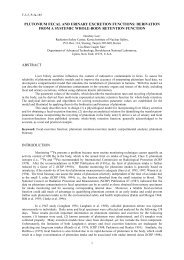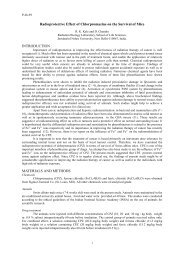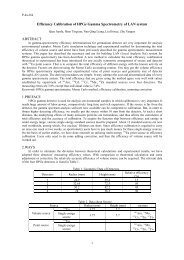Improvements in Diagnostic Techniques in Medicine with Lower ...
Improvements in Diagnostic Techniques in Medicine with Lower ...
Improvements in Diagnostic Techniques in Medicine with Lower ...
You also want an ePaper? Increase the reach of your titles
YUMPU automatically turns print PDFs into web optimized ePapers that Google loves.
T-22-1, P-7-S2<br />
1971: Hounsfield: First CT scanner<br />
1977: Several groups: Digital substraction angiography<br />
1990s: Slip r<strong>in</strong>g helical CT volume imag<strong>in</strong>g<br />
X-RAY TUBES<br />
The x-ray tube serves the function of creat<strong>in</strong>g x-ray photons from electron energy supplied by the x-<br />
ray generator. The process of creat<strong>in</strong>g the x-ray beam is very <strong>in</strong>efficient, <strong>with</strong> only 1% of the electric energy<br />
converted to x-ray photons and rema<strong>in</strong><strong>in</strong>g 99% of converted to heat <strong>in</strong> the x-ray tube assembly. Thus, to produce<br />
sufficient x-ray output for diagnostic imag<strong>in</strong>g, the x-ray tube must <strong>with</strong>stand and dissipate a substantial heat load,<br />
a requirement that affects the design and composition of the x-ray tube.<br />
A basic understand<strong>in</strong>g of the x-ray tube is important because x-ray beam characteristics substantially<br />
affect spatial resolution, image contrast, and patient dose. The x-ray tube components are the cathode, anode<br />
assemblies, and the tube hous<strong>in</strong>g.<br />
The earliest x-ray tube used by Roengen and others were based upon a design implemented by<br />
Crookes gas tube. But the gas tube performance was unreliable <strong>with</strong> regard to standardiz<strong>in</strong>g the operat<strong>in</strong>g tube<br />
voltage and current for specific exam<strong>in</strong>ation and <strong>in</strong>direct x-rays were generated at the tube wall, which affected<br />
the resolution of x-ray image. A significant breakthrough occurred <strong>with</strong> the development of hot cathode<br />
electron source by Coolidge <strong>in</strong> 1913, which improved reproducibility of exposure output, and high heat load<br />
characteristics of the tungsten. But higher <strong>in</strong>stantaneous x-ray output capabilities coupled <strong>with</strong> the<br />
<strong>in</strong>sufficiency of x-ray production at low energies and consequent heat<strong>in</strong>g of anode soon became a problem for<br />
longevity of the anode target. The implementation of rotat<strong>in</strong>g anode x-ray tube <strong>in</strong> 1929 by Bouwers was the<br />
first significant technological advance of Coolidge tube which <strong>in</strong>creased the heat load<strong>in</strong>g limits of stationary<br />
anode design.<br />
Thereafter, the design of x-ray tubes has been developed to the modern types(3).<br />
X-RAY GENERATORS<br />
The x-ray generator provides the power necessary to produce x-rays <strong>with</strong><strong>in</strong> the x-ray tube, and permits<br />
the selection of x-ray energy, x-ray quantity, and exposure time. The circuit consists of a high-voltage<br />
transformer, rectifiers to change the AC current to DC, and a filament, which produces the current <strong>in</strong> the x-ray<br />
tube. Three-phase generator was <strong>in</strong>troduced <strong>in</strong> 1928 by Siemens. Three- phase circuits (6 pulse) have higher<br />
voltage and higher average current values than s<strong>in</strong>gle-phase (2 pulse) circuits. X-ray production is more<br />
efficient at higher voltages. The higher average voltage of three-phase circuit produce more x-rays per<br />
milliampere that can be obta<strong>in</strong>ed <strong>with</strong> a s<strong>in</strong>gle-phase circuit <strong>with</strong> the same average current. Thereafter, the<br />
design of x-ray generator has developed by several <strong>in</strong>vestigators such as constant potential generators (1960's)<br />
and high-frequency generators (1980's). High-frequency <strong>in</strong>verter generator which has been available for the<br />
past 10-15 years, are becom<strong>in</strong>g the universal choice for diagnostic radiographic systems, which improve the<br />
accuracy of diagnostic exam<strong>in</strong>ations, and protect the x-ray tube and patient(4).<br />
IMAGE QUALITY IMPROVEMENT BY REDUCTION OF SCATTERED X- RAY<br />
1) INTENSIFYING SCREENS.<br />
Intensify<strong>in</strong>g screens convert the <strong>in</strong>visible energy of a x-ray beam <strong>in</strong>to visible light energy. About<br />
99% of the latent image on x-ray film is formed because of this visible light created by <strong>in</strong>tensify<strong>in</strong>g screen.<br />
The process of us<strong>in</strong>g <strong>in</strong>tensify<strong>in</strong>g screens <strong>with</strong> film is especially important <strong>in</strong> diagnostic radiology, where<br />
imag<strong>in</strong>g detail and limit<strong>in</strong>g the dose to the patient is more critical. The phosphor layer is the key to the<br />
conversion power of the <strong>in</strong>tensify<strong>in</strong>g screen. Calcium tungstate phosphor screen was first <strong>in</strong>troduced by Edison<br />
<strong>in</strong> 1986 and over the years, several materials have been used as phosphors. Some of the older materials such as<br />
barium plat<strong>in</strong>ocyanide, z<strong>in</strong>c sulfide, barium lead sulfate, and calcium tungstate have a lower conversion factor.<br />
The newer one, rare earth screen such as gadol<strong>in</strong>ium, lanthanum, and yttrium have a more efficient x-ray-light<br />
conversion factor. The conversion factor for rare earth screens average about 15-20% compared <strong>with</strong> 5% for<br />
calcium tungstate screen. Rare-earth screen achieves a 50% more reduction <strong>in</strong> radiation exposure <strong>with</strong>out a<br />
cl<strong>in</strong>ically important decrease <strong>in</strong> image quality. Rare-earth screen, most conta<strong>in</strong><strong>in</strong>g a gadolonium oxysulfide<br />
compound, are <strong>in</strong> wide use today.<br />
2). GRIDS.<br />
Dur<strong>in</strong>g an exposure, reduc<strong>in</strong>g scatter or secondary radiation is essential to improv<strong>in</strong>g image quality.<br />
Less scatter radiation is produced by restrict<strong>in</strong>g the beam through collimation of x-ray shutter blades.<br />
2

















